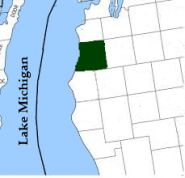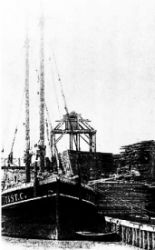- Manistee County -
 Manistee County is
located in the northwest quarter of Michigan's lower peninsula. It is bounded on the south by Mason county, Lake county on the southeast, on the east by Wexford county, Grand Traverse county on the northeast, on the north by Benzie
county and on the west by Lake Michigan. It was formed in 1840 from Mackinaw county and attached to Ottawa county in 1846 for judicial purposes. The county offices, including the justice of the peace,
were located at Grand Haven. To get married the couple would have to travel Grand Haven or Milwaukee as there was no other person closer to perform the ceremony. In 1851 it was attached to Oceana
county, and in 1853 to Grand Traverse county. Manistee county was erected by act of Legislature in the winter of 1854-'55 and organized in the Spring of 1855. Originally the county was divided
into only three townships, Manistee, Stronach and Brown. Today there are fourteen townships in the county.
Manistee County is
located in the northwest quarter of Michigan's lower peninsula. It is bounded on the south by Mason county, Lake county on the southeast, on the east by Wexford county, Grand Traverse county on the northeast, on the north by Benzie
county and on the west by Lake Michigan. It was formed in 1840 from Mackinaw county and attached to Ottawa county in 1846 for judicial purposes. The county offices, including the justice of the peace,
were located at Grand Haven. To get married the couple would have to travel Grand Haven or Milwaukee as there was no other person closer to perform the ceremony. In 1851 it was attached to Oceana
county, and in 1853 to Grand Traverse county. Manistee county was erected by act of Legislature in the winter of 1854-'55 and organized in the Spring of 1855. Originally the county was divided
into only three townships, Manistee, Stronach and Brown. Today there are fourteen townships in the county.
The name Manistee is derived from the Indian title of the river which now bears that name. It is a corruption of the original Chippewa, which, in outward appearance, bears little resemblance to the present name. As to the meaning of the name there appears to be a diversity of opinion. One of Michigan's historians gives its meaning as "The River with Islands." A. S. Wordworth, one of the first white men to visit this river, and who was familiar with the Indian tongue, stated that the name signified "Spirit of the Woods."
A French trader named Campau, from Grand Rapids, made trips to the area as early as 1830 but never settled here. About 1832 a party of men from Massachusetts landed in small boats and, going up the river, commenced to get out square timber to build a dam and block house. The block house was completed when the Indians assembled and by menaces drove them from the area. Afterwards the block house was used as a logging shanty, a whiskey saloon, a dwelling and, at one time, used by gang of counterfeiters.
 "The first steps taken towards making a permanent settlement by the whites was in 1840, when, quite late in the fall, two brothers,
John Stronach of Berrien County, and Joseph Stronach of Muskegon County, entered the mouth of Manistee River in an open boat and passing on, up through
what is now known as Manistee Lake, or more familiarly, "The Little Lake," found about a mile east and south of its head, a site on which they decided
to erect a saw mill. Returning to their homes after this preliminary visit, John and another brother, Adam, returned the following year with machinery
for a small saw mill, some cattle, horses and supplies, transporting the same aboard a small vessel to the mouth of the Manistee River, from which point
it was found necessary to raft the cargo to its destination, on account of the shallowness of the channel. Thus, at what is now known as Old Stronach
Town, was established the first white settlement in Manistee County, and with the erection of the primitive saw mill of the Stronachs began the lumbering
industry in what, within the next half a century, was destined to become one of the great lumber producing ports in the world."
"The first steps taken towards making a permanent settlement by the whites was in 1840, when, quite late in the fall, two brothers,
John Stronach of Berrien County, and Joseph Stronach of Muskegon County, entered the mouth of Manistee River in an open boat and passing on, up through
what is now known as Manistee Lake, or more familiarly, "The Little Lake," found about a mile east and south of its head, a site on which they decided
to erect a saw mill. Returning to their homes after this preliminary visit, John and another brother, Adam, returned the following year with machinery
for a small saw mill, some cattle, horses and supplies, transporting the same aboard a small vessel to the mouth of the Manistee River, from which point
it was found necessary to raft the cargo to its destination, on account of the shallowness of the channel. Thus, at what is now known as Old Stronach
Town, was established the first white settlement in Manistee County, and with the erection of the primitive saw mill of the Stronachs began the lumbering
industry in what, within the next half a century, was destined to become one of the great lumber producing ports in the world."
- Manistee the Salt City of
the Unsalted Seas," pub. American Printing Company, 1910.
Before long the harbor at Manistee was busy with the comings and goings of sailing vessels, their towering masts carrying canvas that snapped in the stiff breezes, and steamers billowing clouds of smoke, which carried the saw mill products to ports all around the Great Lakes and returned with supplies necessary for survival in the remote area of Manistee county. In 1854 the outlet of the river was changed and deepened to accomodate vessel movement. The mouth of the river, where a man could frequently wade across, was increased to a depth of ten feet. In 1882 the Flint and Pere Marquette Railroad found its way to Manistee. In 1887 came the Manistee and Northeastern Railroad, owned and operated by Manistee men. In 1880 Charles Reitz, owner of a saw mill on Manistee Lake, began to dig a salt well and, in 1882, struck an exhaustible bed at a little more than 2,200 feet. Salt well derricks quickly began rising in nearly every mill yard and by 1910 Manistee was called the greatest salt producing center in the world."



